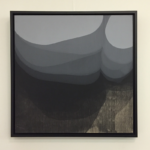The name of this series comes from the progressive layering of thin layers of ink. I’d done a lot with progressive darkening using thin washes of translucent pigments. What I hadn’t experimented with before was thin layers of light, opaque colours. For some reason, I had this idea in my head that they’d always get really granular and gross looking. To some extent, that’s true – but I found that mixing in enough gel medium would suspend the grains of opaque pigment long enough for them to cure in place instead of curdling.

What really sets this series apart though is that most of them are about patient layering through the full cycle of darkening from white paper to almost black and then lightening back up to almost white again. Some of them contain 30 or 40 individual layers of wash. It’s an old technique that goes back to the old masters. As a result, there’s a strong sense of illusory depth to these pictures – progressive recession and then procession – that suggested to me that this might be a way of doing landscapes.
A couple of people have pointed out that some of the shapes in these paintings suggest some of the motifs in Pacific Northwest native art. It’s got me thinking about inspiration versus appropriation. They certainly aren’t intentional allusions to native motifs, but the comments have me thinking more about where the line can and ought to be drawn. I should have a chat with some of the artists I know around here, native and non-native, and see what comes of it.
On another note, that these studies ended up becoming a larger painting (“Progression I”) which ended up being the first painting I sold.
Take a look through the “Progression Series”, and let me know what you think.